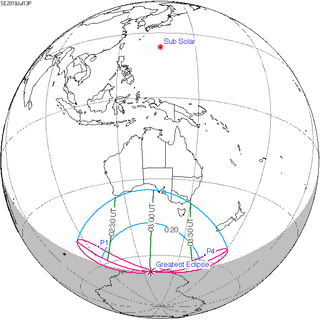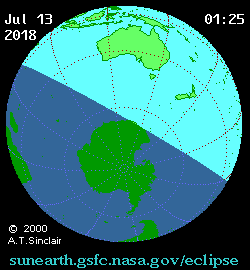| Solar eclipse of July 13, 2018 | |
|---|---|
 From Melbourne, Australia | |
| Type of eclipse | |
| Nature | Partial |
| Gamma | −1.3542 |
| Magnitude | 0.3365 |
| Maximum eclipse | |
| Coordinates | 67°54′S 127°24′E / 67.9°S 127.4°E |
| Times (UTC) | |
| Greatest eclipse | 3:02:16 |
| References | |
| Saros | 117 (69 of 71) |
| Catalog # (SE5000) | 9548 |
A partial solar eclipse occurred on Friday, July 13, 2018.[1][2] A solar eclipse occurs when the Moon passes between Earth and the Sun, thereby totally or partly obscuring the image of the Sun for a viewer on Earth. A partial solar eclipse occurs in the polar regions of the Earth when the center of the Moon's shadow misses the Earth. The moon's penumbra touched a small part of Antarctica, and southern Australia in Tasmania, where the eclipse was observed with a magnitude of about 0.1. The eclipse was also visible in Stewart Island, an island south of New Zealand.[3]
YouTube Encyclopedic
-
1/5Views:6464802 076484656
-
Solar Eclipse July 13th 2018
-
#AstrologyExplained | New Moon Solar Eclipse in Cancer | July 13th 2018 | Start Afresh
-
ECLIPSES JULY AUGUST 2018
-
July 2018 Solar Eclipse New Moon in Cancer
-
#Astrology #Solar Eclipse in Cancer 13th July 2018 #Eclipse Season
Transcription
Images
Related eclipses
Eclipses of 2018
- A total lunar eclipse on January 31.
- A partial solar eclipse on February 15.
- A partial solar eclipse on July 13.
- A total lunar eclipse on July 27.
- A partial solar eclipse on August 11.
Solar eclipses of 2018–2021
This eclipse is a member of a semester series. An eclipse in a semester series of solar eclipses repeats approximately every 177 days and 4 hours (a semester) at alternating nodes of the Moon's orbit.[4]
Note: Partial solar eclipses on February 15, 2018, and August 11, 2018, occurred during the previous semester series.
| Ascending node | Descending node | |||||
|---|---|---|---|---|---|---|
| Saros | Map | Gamma | Saros | Map | Gamma | |
117 Partial from Melbourne, Australia |
2018 July 13 Partial |
−1.35423 | 122 Partial from Nakhodka, Russia |
2019 January 6 Partial |
1.14174 | |
127 La Serena, Chile |
2019 July 2 Total |
−0.64656 | 132 Jaffna, Sri Lanka |
2019 December 26 Annular |
0.41351 | |
137 Beigang, Yunlin, Taiwan |
2020 June 21 Annular |
0.12090 | 142 Gorbea, Chile |
2020 December 14 Total |
−0.29394 | |
147 Partial from Halifax, Canada |
2021 June 10 Annular |
0.91516 | 152 From HMS Protector off South Georgia |
2021 December 4 Total |
−0.95261 | |
Metonic series
The metonic series repeats eclipses every 19 years (6939.69 days), lasting about 5 cycles. Eclipses occur in nearly the same calendar date. In addition, the octon subseries repeats 1/5 of that or every 3.8 years (1387.94 days). All eclipses in this table occur at the Moon's ascending node.
| 21 eclipse events, progressing from south to north between July 13, 2018 and July 12, 2094 | ||||
|---|---|---|---|---|
| July 12–13 | April 30-May 1 | February 16–17 | December 5–6 | September 22–23 |
| 117 | 119 | 121 | 123 | 125 |
 July 13, 2018 |
 April 30, 2022 |
 February 17, 2026 |
 December 5, 2029 |
 September 23, 2033 |
| 127 | 129 | 131 | 133 | 135 |
 July 13, 2037 |
 April 30, 2041 |
 February 16, 2045 |
 December 5, 2048 |
 September 22, 2052 |
| 137 | 139 | 141 | 143 | 145 |
 July 12, 2056 |
 April 30, 2060 |
 February 17, 2064 |
 December 6, 2067 |
 September 23, 2071 |
| 147 | 149 | 151 | 153 | 155 |
 July 13, 2075 |
 May 1, 2079 |
 February 16, 2083 |
 December 6, 2086 |
 September 23, 2090 |
| 157 | ||||
 July 12, 2094 | ||||
References
- ^ "A Supermoon Partial Eclipse Is Happening Just in Time for Friday the 13th". Popular Mechanics. July 13, 2018.
- ^ Padgett, Lauren. "Friday the 13th solar eclipse only visible to rare few" – via AJC.com.
- ^ "Partial Solar Eclipse on July 13, 2018". www.timeanddate.com. Retrieved July 13, 2018.
- ^ van Gent, R.H. "Solar- and Lunar-Eclipse Predictions from Antiquity to the Present". A Catalogue of Eclipse Cycles. Utrecht University. Retrieved 6 October 2018.





